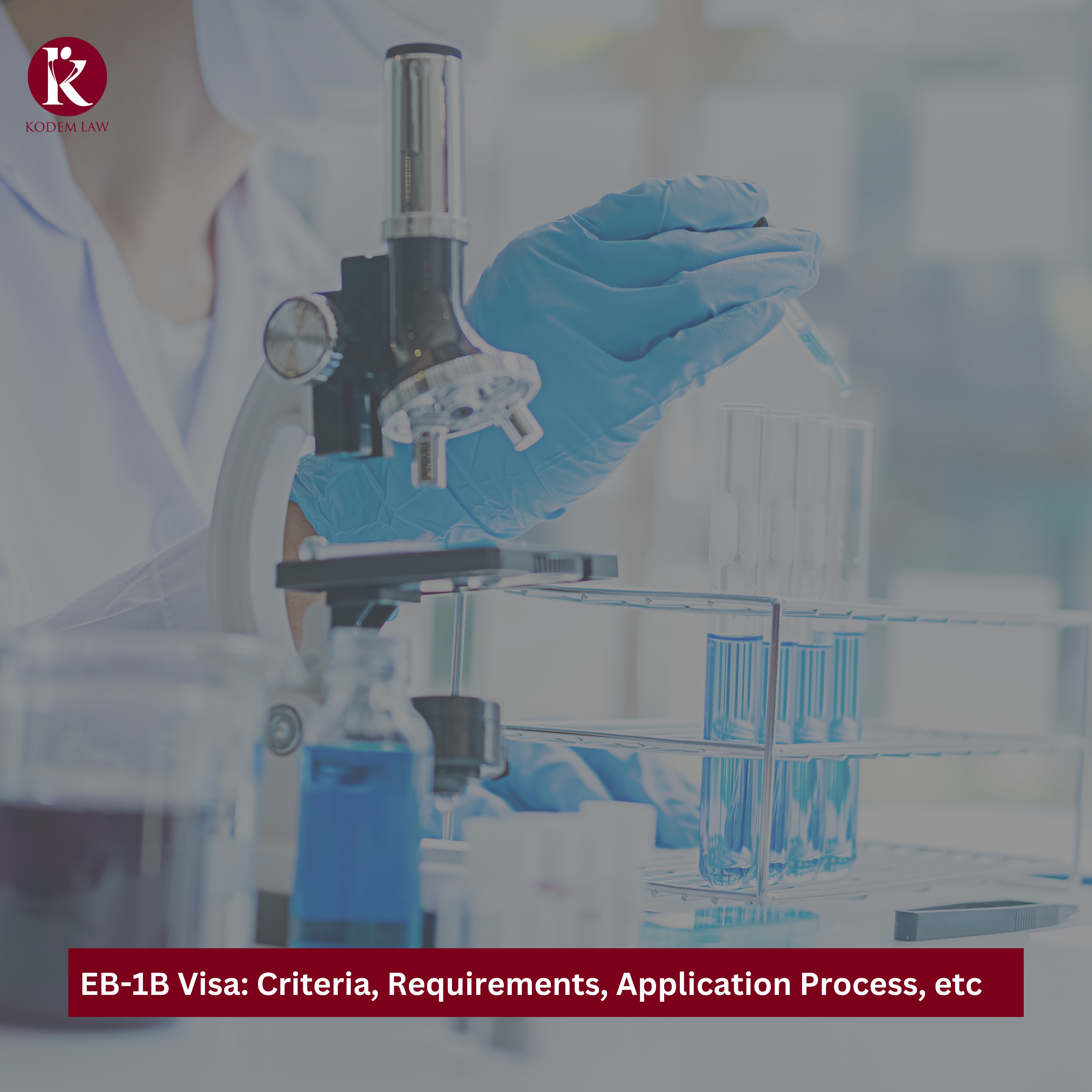
Embarking on a journey to secure a U.S. visa can be both exciting and challenging. For individuals with extraordinary abilities in their respective fields, the EB-1B visa stands as a promising pathway to live and work in the United States.
In this comprehensive guide, we will delve into the intricacies of the EB-1B visa, exploring its criteria, application process, and how it differs from other visa categories.
What is an EB-1B Visa?
The EB-1B visa is a U.S. employment-based immigrant visa designed for outstanding professors and researchers. It allows individuals with exceptional expertise in their academic field to obtain permanent residency, provided they have a sustained record of outstanding achievements, recognized by their peers. The EB-1B petition consists of Form I-140 and supporting documents to show that the alien beneficiary meets EB1 Outstanding Researcher or Professor criteria.
What are EB-1B Criteria?
The EB-1B visa, or E-12 Outstanding Professor or Researcher visa, is designed for individuals who have demonstrated exceptional achievement and recognition in the academic or research fields. The key requirements for the EB-1B visa include:
Demonstrating Outstanding International Recognition:
To establish international recognition, fulfill a minimum of 2 out of 6 criteria:
(a) Proof of significant prizes or awards in your academic field.
(b) Membership in prestigious academic associations requiring exceptional achievement.
(c) Publication of your work in professional publications.
(d) Participation as a judge, individually or on a panel, in your academic field.
(e) Original contributions to scientific or scholarly research.
(f) Authorship of scholarly books or articles in academic journals.
Three Years of Teaching and/or Research Experience:
- Accumulate a minimum of 3 years of experience in teaching and/or conducting research within your academic field.
US Job Offer Requirement:
- Obtain a job offer for a teaching position or research role within the United States to fulfill visa conditions.
Documents Required for EB-1B Visa
- Copy of Passport
- Resume or Curriculum Vitae (CV) detailing educational and professional achievements.
- Awards: Actual award certificates, evidence of award significance, and information on award selection criteria.
- Evidence of Membership in Associations: Association ID card, along with a letter demonstrating membership and outlining membership criteria.
- Letter From Former Employer: Explanation of required work experience, and details of job duties, all presented on official letterhead and signed by an authorized representative.
- Job Offer From US Employer: A job offer from the U.S. employer
- Letters of Endorsement: Letters of Endorsement include endorsement letters from field experts along with concrete evidence supporting these endorsements. These letters should come from individuals not closely acquainted with the applicant.
EB-1B Processing Time
Processing times typically vary and can give a link to USCIS too.
- USCIS processing time for Form I-140 typically ranges from 7 to 13 months.
- Premium Processing (additional fee) can expedite the I-140 processing to 15 calendar days.
- After I-140 approval, processing times for adjustment of status (Form I-485) vary.
- Consular processing times for immigrant visa applications filed through U.S. embassies or consulates abroad may also vary.
- Factors influencing processing time include caseload, USCIS workload, and any additional administrative processing required.
EB-1B Visa Application Process
Securing an EB-1B visa involves a crucial application process. From filing the petition to undergoing the interview, applicants need to follow a step-by-step procedure. Here are the following steps:
- Employer’s Sponsorship: The process begins with an employer in the United States sponsoring the individual for the EB-1B visa.
- Confirmation of Eligibility: Confirm that the individual meets the eligibility criteria for the EB-1B visa, demonstrating extraordinary ability and sustained international recognition in their field.
- Labor Certification (if required): In some cases, the employer may need to obtain labor certification from the U.S. Department of Labor (DOL) to ensure there are no qualified U.S. workers available for the position.
- Filing Form I-140: The employer files Form I-140, Immigrant Petition for Alien Worker, with the USCIS on behalf of the employee.
- Submission of Supporting Documents: Compile and submit a comprehensive set of supporting documents, including evidence of extraordinary ability, sustained recognition, and achievements in the field.
- Premium Processing (Optional): Employers have the option to use premium processing for an additional fee, which expedites the processing time for Form I-140 to 15 calendar days.
- USCIS Review: USCIS reviews the petition and supporting documents to determine if the individual meets the criteria for the EB-1B visa.
- Approval or Request for Additional Evidence (RFE): After submitting your EB-1B Visa application, USCIS may approve it or request more evidence. Approval means meeting requirements, while an RFE seeks additional info for a decision. Respond promptly for a positive outcome.
- Consular Processing or Adjustment of Status: Upon approval, the individual can proceed with either consular processing at a U.S. embassy or consulate abroad or adjusting their status if they are already in the United States.
- Interview (if applicable): Attend an interview at the U.S. embassy or consulate if required. Interviews are not always mandatory but may be requested in certain cases.
- Immigrant Visa Issuance or Adjustment of Status: Once the visa is approved, the individual receives an immigrant visa if processing from abroad or undergoes an adjustment of status if already in the United States.
- Entry into the United States: Upon receiving the immigrant visa or adjusting status, the individual can enter the United States and begin working for the sponsoring employer.

What is the Difference Between EB-1A and EB-1B Visa?
| Criteria | EB-1A Visa | EB-1B Visa |
| Eligibility | Individuals must demonstrate extraordinary ability in their field such as – sciences, arts, education, business, athletics. | Targeted towards outstanding researchers, professors, and individuals with notable achievements in their field. |
| Types of Professions | Covers a wide range of professions, including scientists, artists, educators, business professionals, and athletes. | Primarily for researchers, professors, and those in similar roles who have made significant contributions. |
| Criteria | Requires a high level of sustained national or international acclaim. individuals can self-petition. | Requires a sponsoring employer (petitioner) to file Form I-140 on behalf of the employee. Focuses on sustained accomplishments and recognition in the field. |
| Self-Petition | Yes, individuals can self-petition for the EB-1A visa without employer sponsorship. | No, individuals must have an employer sponsor (petitioner) file the Form I-140 on their behalf for the EB-1B visa. |
| Employment Requirement | Not explicitly tied to specific employment; individuals can pursue self-employment or work with various employers. | Requires a permanent job offer from a U.S. employer (petitioner) in the form of a permanent position or tenure-track position in academia. |
| Documentation | Requires substantial evidence of sustained national or international acclaim, such as major awards, published work, or significant contributions. | Requires documentation of significant contributions to the field, recognition, and impact. Letters of recommendation and evidence of accomplishments are crucial. |
Conclusion
Preparing for the EB-1B visa involves careful attention to detail, meeting strict requirements, and understanding the application process. Kodem Law can help you in understand the ins and outs of this visa category so that you can go through a smooth transition to the United States, showcasing your exceptional skills to a larger audience.

